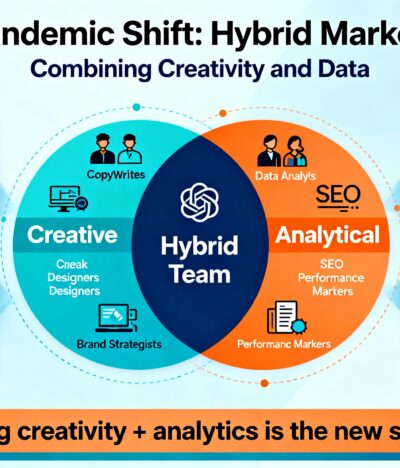YIn today’s rapidly evolving technological landscape, artificial intelligence (AI) is no longer just a tool — it’s a partner. As AI continues to advance, a new model is emerging that blends the strengths of both humans and machines: the Human-AI Hybrid Model. This approach is not about replacing humans with machines but enhancing our capabilities by working alongside intelligent systems.
What Is the Human-AI Hybrid Model?
The Human-AI Hybrid Model refers to a collaborative system where humans and AI systems work together, each complementing the other’s strengths. AI excels at processing vast amounts of data, identifying patterns, and performing repetitive tasks with speed and precision. Humans, on the other hand, bring creativity, emotional intelligence, ethical reasoning, and contextual understanding qualities that machines currently lack.
Real-World Applications
1. Healthcare
Doctors are using AI to assist in diagnosing diseases such as cancer or detecting anomalies medical imaging. For example, AI algorithms can scan thousands of radiology images in seconds and flag potential issues. However, human doctors make the final judgment, using their experience and empathy to interpret results in context and communicate them to patients.Doctors are using AI to assist in diagnosing diseases such as cancer or detecting anomalies in medical imaging. For example, AI algorithms can scan thousands of radiology images in seconds and flag potential issues. However, human doctors make the final judgment, using their experience and empathy to interpret results in context and communicate them to patients.
2. Customer Service
Chatbots powered by AI can handle basic customer inquiries 24/7, reducing wait times and’ operational costs. But when issues become complex or emotionally charged, human agents step in. This division of labor improves efficiency while preserving the human touch in customer experiences.
3. Creative Industries
Writers, musicians, and designers are beginning to use AI tools for inspiration and productivity. AI can generate draft content, suggest melodies, or create visual art ideas. Humans refine the outputs, infuse meaning, and ensure the final product resonates with audiences. The creative process becomes more efficient and even more imaginative.
4. Education
AI tutors can provide personalized learning experiences by analyzing student performance and adapting lesson plans. But teachers remain essential for motivation, emotional support, and contextual teaching. This hybrid model creates more responsive and inclusive educational environments.
The Advantages of Human-AI Collaboration
1.Enhanced Productivity
With AI handling routine or data-heavy tasks, humans can focus on more strategic, meaningful work. This leads to higher job satisfaction and innovation.
2.Improved Accuracy
AI reduces human error in tasks like calculations, data entry, and forecasting. Meanwhile, human oversight ensures that AI outputs are used appropriately and ethically.
3.Better Decision-Making
AI systems can provide data-driven insights, but they lack judgment. Humans use values, intuition, and experience to make decisions — especially in ambiguous or high-stakes situations. The hybrid model supports better choices overall.
4.Scalability
Organizations using hybrid systems can scale operations more quickly. AI handles large volumes of work while humans manage quality control and adaptability.
Challenges and Ethical Considerations
While the Human-AI Hybrid Model has immense potential, it also raises important questions:
1.Bias and Fairness
AI models can inherit biases from their training data. Without human intervention, these biases can go unchecked and lead to unfair outcomes. Continuous human oversight is essential to ensure fairness and accountability.
2.Job Displacement vs. Augmentation
There is ongoing concern that AI might replace human jobs. However, the hybrid model emphasizes augmentation, not replacement. The key is to reskill and upskill workers so they can thrive in AI-assisted roles.
3.Trust and Transparency
Humans must be able to trust AI systems, especially in areas like healthcare, law enforcement, and finance. This requires transparency in how AI systems work and how decisions are made.
4.Responsibility
When mistakes occur in hybrid systems, who is accountable — the human, the machine, or both? Clear frameworks for responsibility are necessary as these systems become more widespread.
The Future of Work and Society
The Human-AI Hybrid Model is not a distant future concept — it’s already happening. As AI becomes more integrated into daily life and work, the ability to collaborate effectively with machines will become a crucial skill.Education systems will need to teach not just coding and data science, but also ethics, critical thinking, and AI literacy. Organizations will need to design workflows and policies that foster smooth human-AI interaction. Governments will need to regulate AI to protect people while encouraging innovation.Most importantly, society must embrace a mindset shift: AI is not a rival to fear, but a partner to understand and leverage.
Conclusion
The Human-AI Hybrid Model marks a pivotal shift in how we think about technology. Rather than humans or AI working in isolation, we are entering an era of **symbiosis** — where collaboration between people and intelligent machines can lead to greater efficiency, creativity, and problem-solving power.Success in this new paradigm depends not only on technological progress but on our ability to design systems that respect human values, build trust, and enhance our collective potential.



